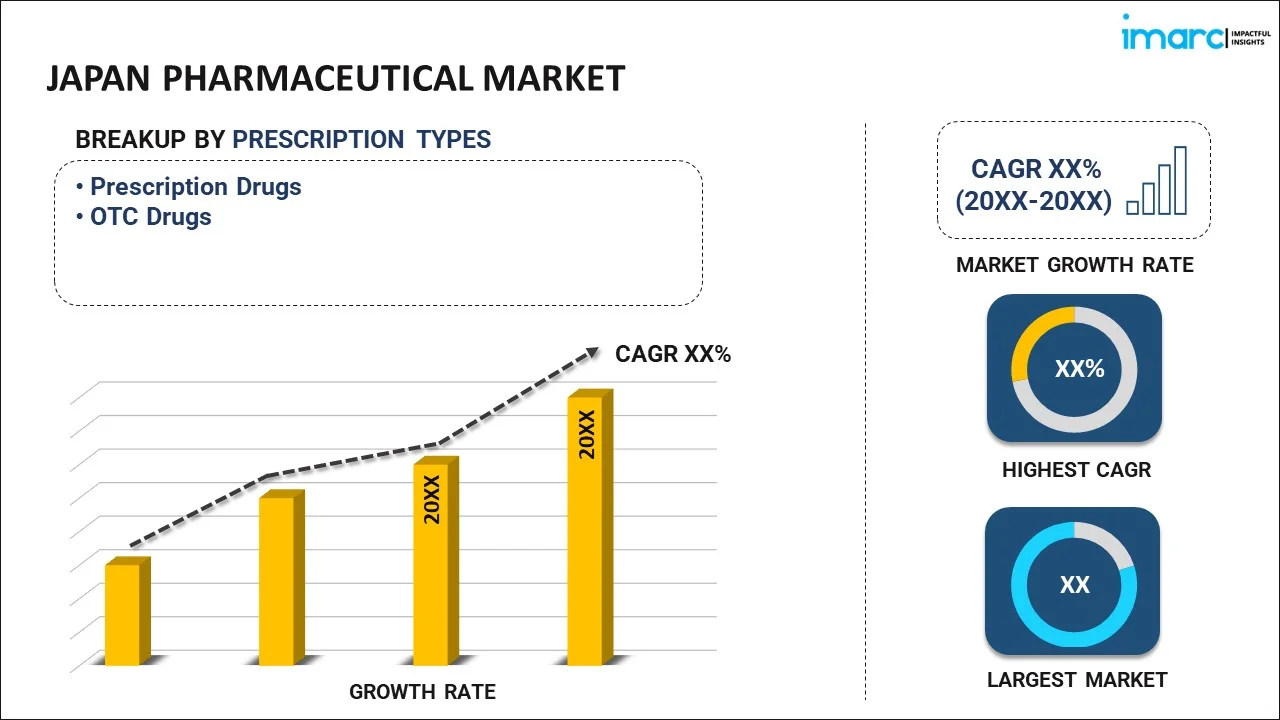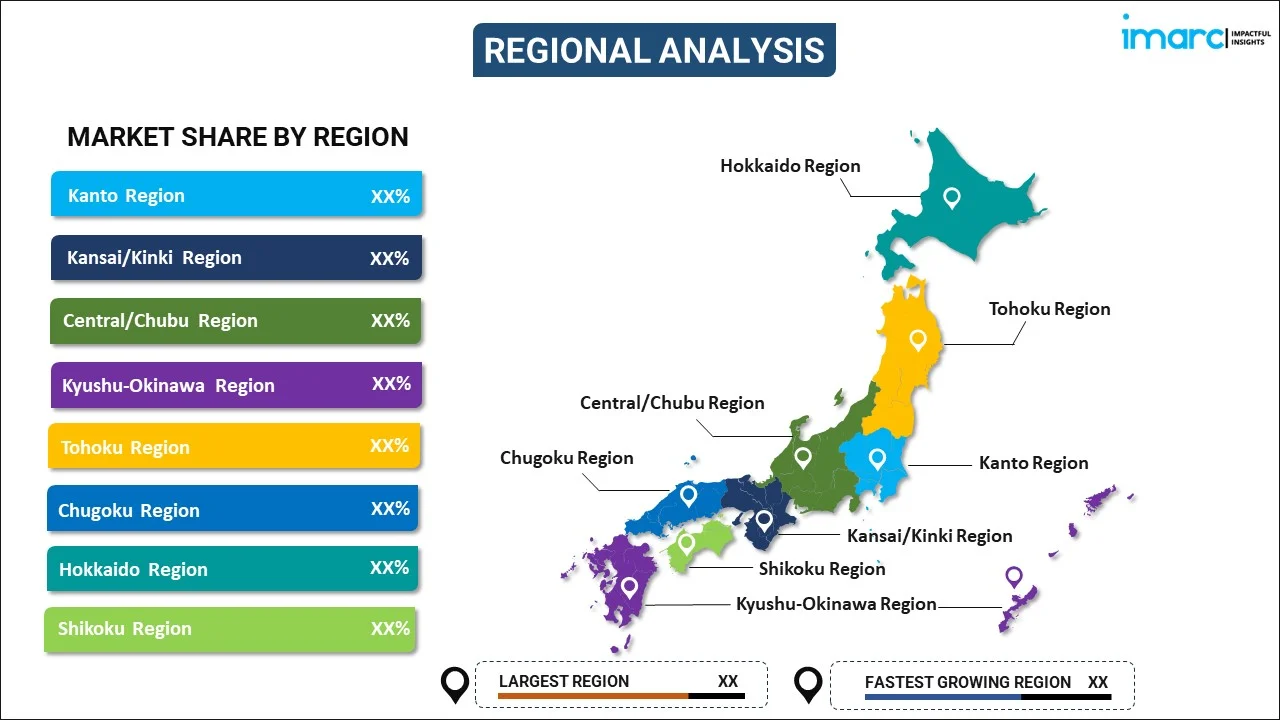
Japan Pharmaceutical Market Report by Prescription Type (Prescription Drugs, OTC Drugs), Therapeutic Category (Antiallergics, Blood and Blood Forming Organs, Cardiovascular System, Dermatological, Genito Urinary System, Respiratory System, Sensory Organs, and Others), and Region 2025-2033
Market Overview:
Japan pharmaceutical market size reached USD 82.27 Billion in 2024. Looking forward, IMARC Group expects the market to reach USD 101.90 Billion by 2033, exhibiting a growth rate (CAGR) of 2.57% during 2025-2033. Numerous treatments and innovative therapies and the increasing investments in the R&D activities for developing medicines, are primarily augmenting the market growth.
|
Report Attribute
|
Key Statistics
|
|---|---|
|
Base Year
|
2024 |
|
Forecast Years
|
2025-2033 |
|
Historical Years
|
2019-2024
|
| Market Size in 2024 | USD 82.27 Billion |
| Market Forecast in 2033 | USD 101.90 Billion |
| Market Growth Rate (2025-2033) | 2.57% |
The pharmaceutical industry represents a confluence of science, innovation, and therapeutic care, dedicated to advancing global health. At its core, this sector is responsible for the research, development, production, and distribution of medications designed to prevent, manage, or cure a plethora of medical conditions and diseases. Spanning from life-saving vaccines to everyday pain relievers, pharmaceuticals play an integral role in enhancing the quality of life and increasing life expectancy. The journey of drug development is a complex and rigorous process, necessitating extensive research, clinical trials, and regulatory approvals to ensure both efficacy and safety for patients. Beyond the tangible medications, the pharmaceutical industry's value also lies in its relentless pursuit of new therapeutic frontiers, breakthrough treatments, and innovations that have the potential to redefine medical paradigms. As health challenges continue to evolve, the importance of this industry, underpinned by its commitment to bettering human health, remains paramount.
Japan Pharmaceutical Market Trends:
Growing investments in biopharmaceuticals and precision medicine
Growing investments in biopharmaceuticals and precision medicines is rapidly transforming the dynamics of the pharmaceutical industry in Japan. Biopharmaceuticals, such as biologics, and biosimilars are gaining more preference due to originality in treatment of chronic diseases, such as cancer or autoimmune diseases. With advancements in genomics and personalized medicine, the focus is shifting towards treatments tailored to individual genetic profiles. As a result, major Japanese drug manufacturers are engaging in joint ventures involving overseas companies and research centers to foster this technology. An enhanced focus on individualized treatments is further extending the range of the pharmaceutical market by offering targeted solutions to previously hard-to-solve diseases.
Aging Population and Rising Healthcare Demand
The rapidly aging population is a key factor propelling growth in the pharmaceutical market. This demographic shift is increasing the overall demand for medications targeting age-related diseases and chronic conditions such as cardiovascular diseases, diabetes, and Alzheimer's. Also, with shifting focus to managing chronic illnesses and improving the quality of life for senior citizens, the demand for effective treatments and medications is growing with the improving healthcare system. Furthermore, pharmaceutical companies are expanding their R&D efforts in geriatric medicines, developing comprehensive drug formulations specifically designed for elderly care. This demographic trend is attracting heavy investments from both local and international firms, contributing to the Japan pharmaceutical market share.
Continual technological advancements in drug development and manufacturing
Ongoing innovations in cutting-edge advancements, such as artificial intelligence (AI), machine learning (ML), and process automation, particularly as they are integrated into both preclinical research and drug manufacturing, are supporting the growth of the market. Data-driven methods in clinical trials and drug safety monitoring are helping pharmaceutical companies bring new therapies to market faster. Wearable devices and digital health tools, including telemedicine are also fostering better drug adherence and more personalized treatment plans. Additionally, innovations in bioprocessing and the use of robotics in pharmaceutical production are improving efficiency, while advanced analytics support better decision-making throughout the drug development lifecycle.
Japan Pharmaceutical Market Segmentation:
IMARC Group provides an analysis of the key trends in each segment of the market, along with forecasts at the country level for 2025-2033. Our report has categorized the market based on prescription type and therapeutic category.
Prescription Type Insights:

- Prescription Drugs
- Branded
- Generics
- OTC Drugs
The report has provided a detailed breakup and analysis of the market based on the prescription type. This includes prescription drugs (branded and generics) and OTC drugs.
Therapeutic Category Insights:
- Antiallergics
- Blood and Blood Forming Organs
- Cardiovascular System
- Dermatological
- Genito Urinary System
- Respiratory System
- Sensory Organs
- Others
A detailed breakup and analysis of the market based on the therapeutic category have also been provided in the report. This includes antiallergics, blood and blood forming organs, cardiovascular system, dermatological, genito urinary system, respiratory system, sensory organs, and others.
Regional Insights:

- Kanto Region
- Kansai/Kinki Region
- Central/ Chubu Region
- Kyushu-Okinawa Region
- Tohoku Region
- Chugoku Region
- Hokkaido Region
- Shikoku Region
The report has also provided a comprehensive analysis of all the major regional markets, which include Kanto Region, Kansai/Kinki Region, Central/ Chubu Region, Kyushu-Okinawa Region, Tohoku Region, Chugoku Region, Hokkaido Region, and Shikoku Region.
Competitive Landscape:
The market research report has also provided a comprehensive analysis of the competitive landscape. Competitive analysis such as market structure, key player positioning, top winning strategies, competitive dashboard, and company evaluation quadrant has been covered in the report. Also, detailed profiles of all major companies have been provided.
Japan Pharmaceutical Market News:
- On 1st October 2024, Nxera Pharma Co., Ltd. formed a partnership agreement with Shionogi & Co., Ltd. regarding the distribution and sales for QUVIVIQ™ (daridorexant 25 and 50 mg) in Japan. QUVIVIQ is a novel dual orexin receptor antagonist, discovered by Idorsia Pharmaceuticals Ltd, that was approved by the ministry of health, labour, and welfare of Japan (“MHLW”) for the treatment of adult patients with insomnia.
Japan Pharmaceutical Market Report Coverage:
| Report Features | Details |
|---|---|
| Base Year of the Analysis | 2024 |
| Historical Period | 2019-2024 |
| Forecast Period | 2025-2033 |
| Units | Billion USD |
| Scope of the Report | Exploration of Historical and Forecast Trends, Industry Catalysts and Challenges, Segment-Wise Historical and Predictive Market Assessment:
|
| Prescription Types Covered |
|
| Therapeutic Categories Covered | Antiallergics, Blood and Blood Forming Organs, Cardiovascular System, Dermatological, Genito Urinary System, Respiratory System, Sensory Organs, Others |
| Regions Covered | Kanto Region, Kansai/Kinki Region, Central/ Chubu Region, Kyushu-Okinawa Region, Tohoku Region, Chugoku Region, Hokkaido Region, Shikoku Region |
| Customization Scope | 10% Free Customization |
| Post-Sale Analyst Support | 10-12 Weeks |
| Delivery Format | PDF and Excel through Email (We can also provide the editable version of the report in PPT/Word format on special request) |
Key Questions Answered in This Report:
- How has the Japan pharmaceutical market performed so far and how will it perform in the coming years?
- What has been the impact of COVID-19 on the Japan pharmaceutical market?
- What is the breakup of the Japan pharmaceutical market on the basis of prescription type?
- What is the breakup of the Japan pharmaceutical market on the basis of therapeutic category?
- What are the various stages in the value chain of the Japan pharmaceutical market?
- What are the key driving factors and challenges in the Japan pharmaceutical?
- What is the structure of the Japan pharmaceutical market and who are the key players?
- What is the degree of competition in the Japan pharmaceutical market?
Key Benefits for Stakeholders:
- IMARC’s industry report offers a comprehensive quantitative analysis of various market segments, historical and current market trends, market forecasts, and dynamics of the Japan pharmaceutical market from 2019-2033.
- The research report provides the latest information on the market drivers, challenges, and opportunities in the Japan pharmaceutical market.
- Porter's five forces analysis assist stakeholders in assessing the impact of new entrants, competitive rivalry, supplier power, buyer power, and the threat of substitution. It helps stakeholders to analyze the level of competition within the Japan pharmaceutical industry and its attractiveness.
- Competitive landscape allows stakeholders to understand their competitive environment and provides an insight into the current positions of key players in the market.
Need more help?
- Speak to our experienced analysts for insights on the current market scenarios.
- Include additional segments and countries to customize the report as per your requirement.
- Gain an unparalleled competitive advantage in your domain by understanding how to utilize the report and positively impacting your operations and revenue.
- For further assistance, please connect with our analysts.
 Inquire Before Buying
Inquire Before Buying
 Speak to an Analyst
Speak to an Analyst
 Request Brochure
Request Brochure
 Request Customization
Request Customization




.webp)




.webp)












